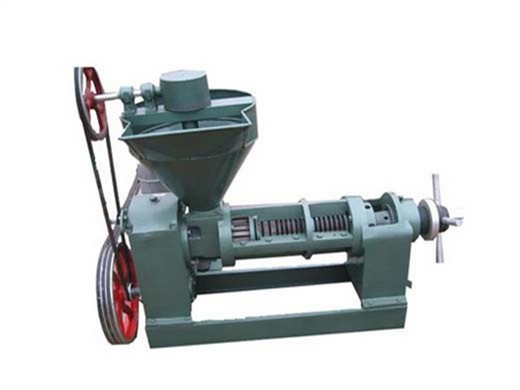automatic extraction oil machine for sesame peanut olive
Oil Expeller. 300W Oil Press Machine Hot Cold Seed Pressing Auto Expeller Extractor 110V Piteba Olive, Nut & Seed Oil Expeller Oil press with olive oil cap / attachment You can use it for peanuts, sesame, nut, corn, soybean, seed and so on.
factory direct pricecold press coconut oil extract machine. 4355 products Black Seed Olive Avocado Home Mini Castor Oil Cold Press Machine Automatic Hydraulic Sesame Almond Black Seed Oil Pressing Pine Nut Walnut Oil Factory Price Indian Vegetable Seeds Black Seed Oil Press Machine . top selling Sesame Oil Extraction Machine Black Seed Cold Oil Press Machine.
how much is cost of palm oil automated extraction machine
Groundnut Oil Extraction Machine Prices in Nigeria (2018) This automatic oil extraction machine is produced and distributed by Zhengzhou QIE, a company with a mark of quality spanning over decades. It can process more than 20 different oil crops including groundnuts, castor bean, soybean, sesame, coconut, rice bran, palm fruit, and even cottonseed.
Grape Seed Oil is processed from the seeds of grapes,which are formed as a by-product of wine making. sesame seed and pumpkin seed. air dried to the machine and then this machine would
cold oil press machine prickly ash seed oil press machine
cold oil press machine prickly ash seed oil press machine peanut oil miller oil making machinery, VEVOR Oil Press Machine Stainless Steel Oil ,The oil press machine is very easy to use; just plug in, feed the seeds into the hopper, . This automatic oil press machine can be used with beans, peanuts, sesame . Rbaysale 700W Oil Press Machine Automatic Hot Cold Oil Extractor Machine .
Rotary Cold Press is suitable to expel oil from oil seeds like white and black sesame, simsim, coconut, almond, peanut and other soft oil seed. The extraction of oil is less compared to expellers but the advantage is that the oil has better aroma and fragrance, better nutritional value suitable for application of carrier oil for massage oil
high yield almond hydraulic cold oil press
high yield hydraulic cold press oil machine oil mill machine The Best Hydraulic Oilseed Press for Oil Extraction Offered in China, Sesame Oil Expeller. Hydraulic oil press is widely used for pressing sesame, walnut, almond, etc.High oil yield and purer oil make our hydraulic oil extractor favored widely.The whole machine is scientifically
Samson Juicer (Ivory) including Cold-Press Oil Press We pay the UPS ground shipping to 48 US States on this juicer: Click on image to enlarge Cold-Pressed Oil Extractor The Samson Single Gear Juicer with Included cold press oil extractor allows you press your own oil! Make oils such as flax, sunflower, sesame, chia and other Oil Seeds.
Castor Oil Press Machine, Castor Oil Expeller
Having wide applications, castor oil extraction machine can also process peanut, rapeseed, soybean, sunflower seed, camellia seed, cottonseed, copra, palm kernel, corn germ, sesame, walnut, etc. Castor bean shelling machine is available for shelling the castor seeds.
sesame oil press mill for saudi arabia for greece | Oil. Saudi Arabia Olive Oil, Saudi Arabia Olive Oil. About 56% of these are oil pressers, 9% are bentonite, and 8% are toilet soap.Cheap Portable Saudi Arabia Hot and Cold Oil Press Machine About product and suppliers: offers 62 saudi.
- Does pressing temperature affect the quality of extracted sesame oil?
- In this research, sesame oil was extracted by pressing at four temperatures, namely, 30 (control sample), 60, 90 and 120 °C, to evaluate its effects on the quality of extracted oils. Oil extraction yields were increased from 38 to 51% by increasing the pressing temperature.
- How is sesame oil extracted?
- Sesame oil is extracted at industrial scales and also in small scale by cold pressing at different temperatures. In this research, sesame oil was extracted by pressing at four temperatures, namely, 30 (control sample), 60, 90 and 120 °C, to evaluate its effects on the quality of extracted oils.
- Is mechanical oil extraction better than solvent oil extraction?
- Compared with solvent oil extraction, mechanical oil pressing extraction method has higher oil quality and safety. The mechanical extracted oil is pure without organic solvent. In the research, castor seeds compression‐structural damage property and oil extraction mechanism were studied.
- Why is sesame oil used in the daily diet?
- Sesame oil has been widely used in the daily diet due to its high nutritional value. Sesame oil is extracted at industrial scales and also in small scale by cold pressing at different temperatures.
- Does unidirectional hydraulic pressing affect continuous oil expression?
- Discontinuous hydraulic pressing leads to the similar performance changes as continuous screw pressing. Therefore, the unidirectional hydraulic pressing may be a first approach to evaluate the effect of these pre-treatments on the continuous oil expression.






